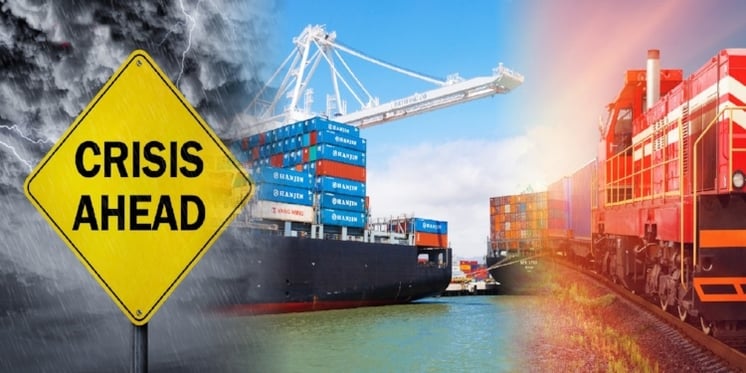CEOs Need to Act Now to Avoid Transportation Crisis Hitting Their Business Hard
What's the problem?
The early signs are not good. Faster economic growth, a shortage of drivers, increases in environmental restrictions and reduced capacity across North America's truck and rail network are already hitting costs, margins and delivery times. Freight prices are forecast to increase by 10-15% in 2018, with companies reporting uncertain delivery times, deteriorating margins, and some already set to issue profit warnings.
In the trucking sector, a recent surge in mandatory regulatory compliance combined with a chronic shortage of drivers due to new government regulation for drivers and truck availability, is pushing up freight costs. With the April 1 enforcement deadline for a federal regulation requiring drivers to electronically log their hours, many truckers are leaving the sector. Instead, they are choosing to work more sociable hours in other industries, such as the booming construction sector, where wages are higher. This is a significant problem given truck freight represents approximately 85% of the US market freight spend, with air & air-truck an additional 8.7% compared to just 2.1% for ocean and 4.3% for rail.
The problem for the railroads is just as acute. Class 1 railroads have, in the last year, cut locomotives, rail cars and crews, and lengthened trains to lower expenses and improve operating margins. As a result, there is no slack left in the system to cope with the uptick in demand or unpredictable weather situations. This is compounded by the fact railroads have little incentive to build extra capacity when increasing rates is more attractive to their bottom line. This is largely due to shippers being unwilling to commit to long-term contracts. For example, in the oil business, given new pipelines such as Keystone set to come on line, companies have more options for moving their capacity versus committing to long-term rail contracts.

Many companies who are interested in expanding capacity in North America, as the new tax laws create opportunity, may find their original CapEx business cases being eroded by this, somewhat invisible, constraint in transportation. The ballooning logistics costs and a lack of transportation capacity must be incorporated in business cases. Boards and shareholders are increasingly scrutinizing management's response to this impending crisis as it threatens to increase inventory levels, warehouse and other supply chain costs. The transportation challenges will directly impact margins, customer service, delivery times, revenue, earnings and, potentially, even corporate survival. CEOs need to take ownership of this issue and act now.
What's the solution?The current transportation shortfalls and imbalances across corporate America require a new strategic approach to achieving greater reliability with minimal disruptions. Companies need to obtain lower costs, easier and more direct route utilization, intermodal optimization and increased optionality across the buy-make-move-fulfill supply chain. Considerations in optimizing the supply chain and operations must include creating a win-win scenario for the variety of carriers and the shipper.
Having helped nearly two-hundred shippers across North America optimize their supply chain and operations, we understand the challenges faced in today's complex environment. We've worked with many CEOs on major initiatives to help transform their supply chain and intermodal transportation capabilities. The game-changing partnerships we have orchestrated at CEO-to-CEO level, have produced far different and better results than competitors within our clients' industry sectors have traditionally achieved.
For instance, a multibillion-dollar manufacturer of nylon made a dramatic shift in product shipping quantities and packaging to reimagine its approach in response to global market changes. Maine Pointe was engaged to work with the manufacturer, its rail, road and ocean carriers to help serve this global marketplace. The solution involved implementing a radical new way of approaching the market place with a reconfigured distribution network built on strong collaborative relationships. As a result, carriers benefited from an 80% growth in volumes and a 22% margin enhancement. At the same time, our client, the nylon shipper, transformed its procurement and logistics operations to improve product transit times from 7-12 days to less than 24 hours. Our client was able to reduce inventory working capital by over $30M in addition to enhancing its own sales and margins.
To create a win-win scenario, carriers' CEOs need to be convinced of the soundness of the shippers' business strategy before committing scarce capacity in a controlled price environment for an extended period of time. Whereas shippers' CEOs need the carriers to understand their need for a sound, cost- effective supply chain and logistics strategy that will deliver for them in the short, medium and long-term.
By taking on the increasing complexity of multimodal solutions to enable further optimization of your buy-make-move-fulfill supply chain, companies can achieve true Total Value Optimization™. CEOs and their companies can proactively take control through such creative and effective solutions, get ahead of the competition, and avoid the impending North American transportation crisis.
Alternatively, learn more about how the TVO framework provides a clear pathway to transform your supply chain into a competitive weapon, read Steven Bowen's Total Value Optimization Book.
About Us
Maine Pointe is a global supply chain and operations consulting firm trusted by many chief executives and private equity firms to drive compelling economic returns for their companies. We achieve this by delivering accelerated, sustainable improvements in EBITDA, cash and growth across their procurement, logistics and operations. Our hands-on implementation experts work with executives and their teams to rapidly break through functional silos and transform the buy-make-move-fulfill supply chain to deliver the greatest value to customers and investors at the lowest cost to business. We call this Total Value Optimization (TVO)™.
Maine Pointe's engagements are results-driven and deliver between 4:1-8:1 ROI. We are so confident in our work and our processes that we provide a unique 100% guarantee of engagement fees based on annualized savings. www.mainepointe.com

